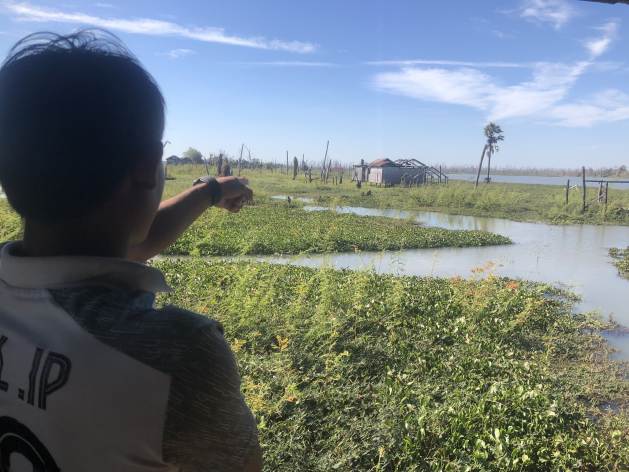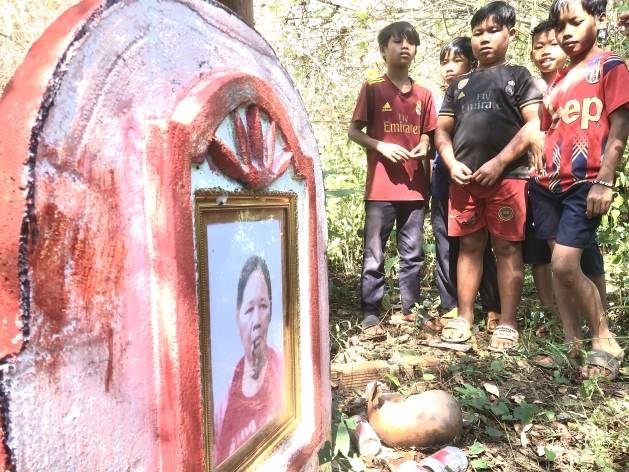Centuries-Old Rituals Are Slowly Fading Away in Cambodia

RATANAKIRI PROVINCE, Cambodia, Jan 18 (IPS) - “What on earth are you going to do in Tropeang Krohom?” The driver of the minivan turns his head and gives me a puzzled look. Few passengers want to be dropped off in a settlement between two provincial towns.
Tropeang Krohom or ‘Red Pond’ is located at a junction of the main road. The name refers to the typical blood-red earth in this province of Ratanakiri.
From this point, a motorcyclist will take me to his village. It is a ride of more than two hours, along bumpy and unpaved roads, with large trails of dust behind passing trucks. The leaves of the grayish-green trees are covered with a thick layer of the same red sand.
Stretched out valleys
Everyone is en route to somewhere. Some are packed lightly, others carry cartloads of vegetables, cassava or sugar cane stalks, to be transported from the field to the market. A street vendor travels from one village to another on his motorbike, loaded with small items for sale such as soap, candy, or soft drinks.
About 1 percent of the total population of 17 million inhabitants live in this area. This province mainly consists of villages, each populated by 60-something families, spread across vast valleys. I go to Kbaal Romeas (literally ‘head of the rhinoceros’) next to Srepok, a tributary of the Mekong.
Cambodia’s northeast is home to more than 20 ethnic groups or Indigenous People. They each have their own story and particular customs, from death cults to love huts, and they have specific languages, although nowadays rarely used.
Young people prefer switching to Khmer, the language of the largest Cambodian ethnicity, which is slowly wiping out the others.
In this province, the clash between tradition and development became painfully clear in 2017, when a huge dam was built at the confluence of the Srepok and the Sesan rivers in Ratanakiri’s west. The power plant turned an inhabited area of ??34,000 hectares into a huge water reservoir. Thousands of residents had to be relocated to a place with newly built houses and expansion options. But about 50 'Pounong' families refuse to leave.
At first, they used small boats to row over the flooded village road. Later, the typical shaded areas under the stilt houses slowly filled with water.

Stubborn resistance
Today, the villagers live a little further away, still within rowing distance of the old spot. Ironically, this area close to a hydroelectric power station is not connected to the grid. People here don't want to pay for electricity from that ‘doomed’ dam anyway. A Cambodian NGO supporting the stubborn resistance is providing solar panels to power night lights and to charge mobile phones.
“I have been to the new village a few times to visit a sick relative, but I will never live there,” says Poo, 64. He shows me his rice field, which has just been harvested. “This land is my identity,” he adds. I know a few Cambodian words for “tradition” or “origin,” but this man uses them all in one sentence.
According to many ethnic traditions, bodies are not cremated as in the Buddhist culture, but buried. This also goes for Pounong people, who believe that the spirits of the deceased are still wandering around the burial site. This is the main reason why the community doesn’t want to leave.
The cemetery of Kbaal Romeas is completely flooded and can no longer be visited. To find out more about this death cult, I travel to other villages in northeastern Cambodia, closer to Laos and Vietnam. The current borders between the three countries of former Indochina were established by the French in the 1950s, but these minority groups have been living here much longer.
In the Tompoun village of Katai, about 20 kilometers in a straight line to the Vietnamese border, I ask a young woman to take me to the ‘prey khmaoch’ or ghost forest. She refuses. Once bodies are ritually buried, they are left to nature. Living souls shouldn’t interfere any more, she says.
Five children are willing to guide me if I promise we will stay together as a group. I see two boys holding hands, one of them whispers he’s quite afraid. Once in the forest, the only sounds we hear come from the dry leaves under our feet and from cawing crows high up in the trees.
Suddenly, the first grave appears in front of us. It is a wooden construction with decorations and a stone stating the date of death and a picture of a woman with a typical pipe in her mouth. Other small wooden graves, scattered around the trees, are in an advanced stage of decay. This place is macabre and peaceful at the same time.
Water buffalo
The burial tradition also exists in the Charai community. Leejapheuy, 68, sits on a bench in the sand under a canvas, in the middle of his village, Loom. A retired soldier who has lived in this village all his life, he has that confident attitude of someone who’s seen it all.
It turns out he is the sculptor who makes the wooden animistic guards, protecting the spirits. In the death forest, I see a statue of a man holding a gun and a sculpted elephant. As the story goes, a water buffalo is to be slaughtered for every burial, but more and more families are abandoning this practice because the animal can easily cost a few hundred dollars.
The journey continues along winding dirt roads and narrow bridges, crisscrossing the rough landscape, which turns into one big mud puddle during the rainy season.
Along the way, we see workers on cassava plantations. 12-year-old Seth comes from Kandal province, more than 500 kilometers south, next to the capital city Phnom Penh. He says he is only here for the harvest and will return to school in his hometown afterward. “This is also a reason why traditional cultures disappear,” says Mana, 37, my motorcyclist. Seasonal laborers and temporary residents do not follow the ancient customs.
The landscape changes and we pass miles of rubber plantations, recognizable by the black bowl on every tree trunk. “Ten years ago these roads were much narrower,” Mana recalls. “But these rubber companies have signed large land concessions and want to be able to drive their big trucks deep into the forest.”
Original inhabitants retreating
Around noon we arrive in Ta Veng, another village with elementary wooden houses on sandy soil. A few neighbors are crouched on the ground around a fire bowl with glowing charcoal. The lunch consists of home-harvested vegetables with sifted rice. Dogs come running towards us, barking at the top of their lungs. Pigs roam freely. Barefoot children shout from afar that visitors have arrived.
We are welcomed by Makara, who has married into this Prouw community. He limps a bit (“an anomaly from my childhood”), but that doesn't stop him from showing us around the village. He finds traditional culture interesting, but he thinks there is also an important practical aspect.
“Monks in the Buddhist pagoda carry out cremations for free,” says Makara, “while funerals do cost a bit.” He also notices that more and more Khmer immigrants buy land and plantations in this area. “The original inhabitants are moving deeper into the forest.”
Love hut
On the way back we pass several Kreung villages. This community is known for its ‘love huts’, small private houses where daughters of marriageable age receive boyfriends. The tradition arose because it is difficult to ‘date’ in a remote village.
“In my time, I had three lovers in a hut like that before I met my current husband,” says Semapohean, 60, laughing. “And yes, the boys were allowed to sleep over. One or two nights before I’d send them away.” Here, it was girls who got to choose their favorite candidates. The custom is notable in a country where marriages are not necessarily arranged, but often require family approval.
But today the love huts no longer exist. “Every now and then we build one to show to tourists, but nowadays people use their phones to meet each other”. In addition, families now live in larger houses, where the children have a separate room and therefore sufficient privacy. Semapohean doesn’t seem to mind that much.
Sookanjerai, 52, is more pessimistic. “This new generation is too lazy to continue the tradition,” he says. Young people do not necessarily want to leave the area, but they lose interest in the specific customs. Sookanjerai has little hope for the future “In a few years from now everyone will have become Khmer and our ethnicities will be gone.”
© Inter Press Service (2024) — All Rights Reserved. Original source: Inter Press Service
 Global Issues
Global Issues